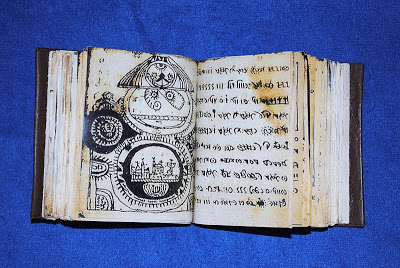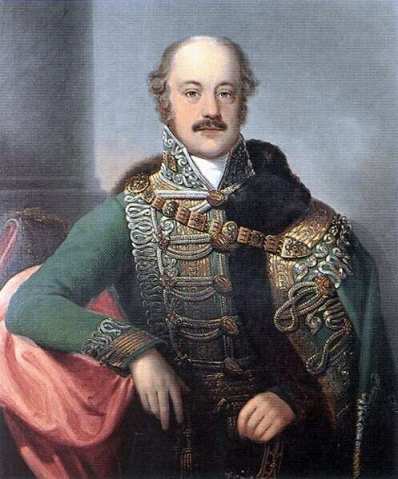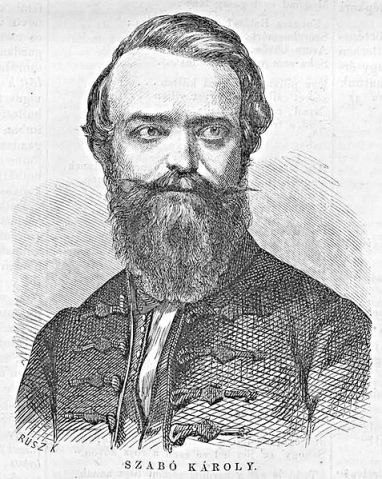The Codex is at the Library of the Hungarian Academy of Science, donated in 1838 by Graf Gusztáv Batthyány, as part of his library from Rohonc (now Rechnitz in Austria).
All additional information to the Wikipedia article is from Némethi Kálmán’s work – Rohonczi Codex Tantétel, Budapest, 1892. Unfortunately, the book is no longer available on-line.
This is how the Codex from Rohonc looks.
 from Damadenegro
from Damadenegro
Here are some basics. It is written in black ink on paper, has 224 folios, 448 pages, one page is 120×100 mm, bound in a leather case. Szabo Jozsef wrote between the pages in pencil, as he tried to decode it. Jerney János identified the paper based on the watermark (an anchor with a star) as being manufactured in northern Italy around 1530. Both the leather cover and the pages are heavily worn, as if it was intensely handled. The Codex consists of 20 gatherings, sewn together to the cover, without glue or signs of craftsmanship. The lack of skills shown in bookbinding matches the scribe’s poor abilities as illustrator. 4 gatherings at the beginning and one at the end are loose. The pages were numbered at some point, after it entered the Academy Library, the numbering is consistent with the left to right reading of the book.
The official library description states that it is a 19thcentury counterfeit.
In an effort to determine whether the book was in the Rohonc library earlier than the 19th century, an entry was found in the 1743 inventory, for a book with the same size and the description “Hungarian prayers”.
The writing is unknown, the graphemes were identified by researchers as Hungarian runes, a Brahmi script variant, Cyrillic or Greek letters, Dacian script. The number of “letters” seems to be in the range of hundreds.
The pages are illustrated with more than 90 drawings in black ink, with inscriptions. Whereas some are clearly identifiable as scenes from the Bible, others are not as easily recognizable. The characters are depicted in mystical poses, with lots of suns, stars and crescent moons displayed.
The text seems to be divided into chapters, the dividers being shaped as snakes in most of the cases.
On request, the administrator of the site Dacia.org got a microfilmed copy from the Hungarian Academy of Sciences, which he made available on-line. The facsimile images reproduce the pages in their succession in the book. The on-line variant misses pages 17, 36, 122, 173-179, 198. It is there.
The book written by Viorica Enachiuc includes a neat facsimile for each page of the Codex. I don’t own it but I found it at the University Library in Cluj and I managed to make copies of the pages missing from the site. For some obscure reason I only made copies of the pages with pictures (I was in Cluj with some other problems and I wasn’t thinking quite clearly). I have at this point 93 pictures of which 10 are dividers: 7 snakes, two slightly embellished lines and a very elaborate one.
Truth is that it is difficult to say if there are not more dividers – I talk about them more in Hic Sunt Serpentes.
The fate of the book was sealed very early after it surfaced. In April 1839 two agents of the Hungarian Academy, Toldy Ferenc and Nagy Károly, went to Rohonc to take over the generous donation. That is when they found the Codex and quickly linked it to other artifacts bearing Hungarian runes, some of them (then) recent discoveries. Among them were the Turoc tables, Toldy being one of their great enthusiasts. Later, the tables were proven to be forgeries linked to a remarkable character, Literáti Nemes Sámuel. I found some really interesting information on him in an article written by Kelecsény Ákos, Egy magyar régiségkereskedő a 19. században Literati Nemes Sámuel (1794-1842).
Literati Nemes Sámuel was a controversial figure. A born Székely from Marosvásárhely (now Târgu Mureş in Romania), he was a nationalist to the core, in a period when nationalism was all the rage, to the point that he considered the biblical personalities to be Hungarians. The man rummaged over a great part of Europe looking for relics, mainly for his commissioner, Jankovich Miklos, an aristocrat, historian and prominent books and antiquities collector. In this position, he discovered many valuable manuscripts and books, which found their way into public collections, preventing them from being lost or destroyed.
 Jankovich Miklos – painting by Peski Jozsef – Wikipedia
Jankovich Miklos – painting by Peski Jozsef – Wikipedia
Literati himself was collecting everything. In a note to his young child, he promises her for Christmas a pretty wooden angel, an intact mammoth jaw and a giant mammoth rib, the horn of a unicorn, and a turtle. But his true passion was anything related to Old Hungarians. He was ready for a fistfight if a relic was significant to his people’s history. Once, he got interested in two flags owned by the Saxon Lutheran priest from a Transylvanian village, flags he would have done anything to procure. The poor priest only escaped a pugnacious encounter because he was on his deathbed. In his fervor, when he couldn’t find artifacts spectacular enough, he manufactured them. He is responsible for the wooden book from Turoc and a Hungarian prayer book from the time of András I. Not for finding them, for creating them.
As the interest in the Codex grew, a respectable and exasperated historian, Szabo Károly (by the way, the link on Wikipedia sends to the wrong Szabo Károly), buried it in contempt, linking it to the ill-famed Literáti.
Research on the Codex did not loose momentum immediately, even the Jirečeks (the son being the creator of the Jireček line concept) got involved, but as it yielded no results, the hypothesis of a hoax gained more and more credibility. It is understandable. First the association with Literati, than the repeated frustration of finding no sense in the script. A closer look to the text of the Codex will definitely exasperate anyone. However, the association with Literati was made because of the alleged Hungarian Runes or Szekely Rovas Iras identified in the script when first seen. Obviously, the characters in the Rohonc Codex are not straightforward Hungarian Runes, or the script would have been deciphered long ago. More talk on this in : “If This Script Makes Any Sense” . From time to time, the interest towards the Codex re-emerges, and new elements or interpretations are given, but nobody have, so far, given the final answer, one to be generally accepted.
Halfway through writing my blog entries, I revisited the Wikipedia article on the Codex, which I haven’t done for quite a while. It shows great news. Hungarian scholars are making progress in deciphering it. Unfortunately, I did not know of their work and did not have access to it. But, Benedek Lang has published a book. I knew he wrote an article, which I didn’t find (the way I like it, for free), but I read an interview with him. So, I ordered the book, but it will take another month before I get it and some more to read it with my poor Hungarian. However, I think his conclusions are presented in the interview, basically, that it could be a cipher, a shorthand system or an artificial language. Or maybe, all three of them. For the work done by others, please visit the Wikipedia article.
In the end, the codex is an oddity, an ugly little piece of work. But somebody put a lot of effort into making it, and it meant something to him. He handled it a lot, as the worn cover shows, so probably it was used for something. And this is the mystery, the appeal of the book, and this is what I try to find out – what the heck was it made for.



Just dropping you a line to tell you that I really appreciate what you did here. It seems to be some amazing piece of work. I am no expert in anything either, just someone who at some point got fascinated with this odd little book. I am just at the beginning of reading your blog but I am really looking forward to reading through all of it and finding out about your ideas!
Thank you for taking the time to comment. I hope you will enjoy my work. I really loved the time spent with the Codex. I am pondering on the idea of making a Facebook page for the few of us interested in it.
I would definitely join such a facebook group. It could actually be a great way to bring people and ideas together to share their thoughts, ideas and maybe some bits of knowledge on the Rohonci codex. And draw a bit more attention on it as well! Who knows what will come out of it …
And here we go: The Codex from Rohonc and Other Cipher Mysteries is on Facebook